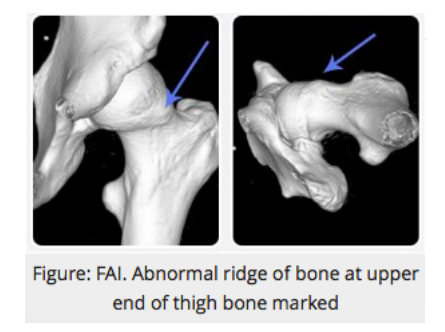Femero Acetabular Impingement (FAI)
Femoroacetabular impingement or FAI is a condition of too much friction in the hip joint. Basically, the ball (femoral head) and socket (acetabulum) rub abnormally creating damage to the hip joint. The damage can occur to the articular cartilage (smooth surface of the ball or socket) or the labral cartilage (soft tissue bumper of the socket). FAI is a leading cause for the development of osteoarthritis, particularly in men.
An abnormality in the shape of the hip joint bones may be present at birth or may develop in early childhood after some childhood hip conditions. In most cases the condition has been asymptomatic for many years. The hip becomes painful when there has been enough damage in the joint.
The first symptom is usually mild groin discomfort. Once the joint becomes painful, there is usually a gradual deterioration. Reducing activity levels may reduce the symptoms.
Symptoms fluctuate according to activity levels and are often made worse by sport and activities which require deep bending of the hip (for example getting out of a car).
Some patients report recurrent ‘groin sprains’ which typically are slow to settle or recur easily. Over time, FAI causes progressive damage to the cartilage on the rim of the hip socket, leading to osteoarthritis.
While osteoarthritis develops over a long time, surgical treatment of the abnormality causing FAI may slow or prevent the progression of joint damage and improve symptoms.

Treatment for hip impingement
The hip is actually a ball and socket joint. A number of structures surround the area, and can all effect the hip, including the lumbar spine. A holistic approach is therefore beneficial to managing hip injuries.
Treatment for hip problems first requires the correct diagnoses. Upon assessment, further investigations may be required such as an xray or scan such as an ultrasound or MRI, to assist with confirmation.
Conservative Treatment
Many patients with early damage can manage their symptoms without requiring surgery. This particularly involves working on the stabilising muscles of the hip and pelvis to control movements and reduce the stress on the hip and pelvis complex.
For persistent symptoms or significant traumatic injury, acetabular labral tears can often be successfully treated with hip arthroscopy (key hole surgery).
Patient’s with structural abnormality of the hip joint, may need consideration made to correcting the underlying cause for the labral tear.
Operative Treatment
Surgical treatment depends on the type of FAI and its cause. In the absence of significant arthritis, many patients will benefit from hip arthroscopy (minimally invasive key-hole surgery).
Other surgical treatments for FAI include open debridement, femoral osteotomy and triple pelvic osteotomy. Knowing which procedure is most appropriate for an individual patient requires clinical assessment.
Arthroscopy is key-hole surgery using a pencil sized fibre-optic camera. It allows safe access into the joint so that the surgeon can accurately assess damage to the joint and perform corrective procedures where required.
Previously, accessing the hip joint required extensive open procedures with large incisions. Hip arthroscopy is a minimally invasive procedure which allows rapid post-operative recovery. It is useful in the treatment of selected hip disorders. Hip arthroscopy can used to treat the symptoms of pain or catching associated with early damage to the hip joint.
Arthroscopy can also be used to treat hip impingement syndrome. It is useful for the accurate diagnosis of hip pathology and the assessment of suitability for other joint preservation techniques. Often It can be a first step in surgical treatment of hip problems.
The most common types of FAI can often be treated with arthroscopic bone reshaping procedure called an osteoplasty. Arthroscopy lends itself to a relatively rapid post-operative recovery. Most patients can weight bear with crutches immediately after the surgery. You will be informed if this is not the case. Crutches may be used for comfort where necessary and are only usually required for 2 weeks. It is advisable not to over exert too quickly after the operation as this can increase discomfort and swelling. Normal activities can be gradually reintroduced within comfort levels.
Most patients are able to drive a car after review. People with desk jobs may return to work as early as 1-2 weeks after the arthroscopy, while people in heavy manual employment may require 6 weeks off work. Sport can often be reintroduced around 3 months. 80% of high level and elite athletes return to match fitness by 16 weeks. A small number of patients may have ongoing mild discomfort for up to 3-4 months after the procedure, depending on the degree of joint damage present at arthroscopy
Glenferrie Sports and Spinal Clinic is located in Hawthorn. Situated conveniently near public transport and with convenient parking it is central to Camberwell, Kew, Richmond, Toorak and Malvern.
For appointments call 03 9815 2555, or book online here














